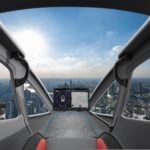Most people walk through life looking straight ahead. Constantly moving, performing their daily activities as quickly and efficiently as possible. For us, our gaze tends to travel upward. As lighting designers, what has become part of the background for most people fascinates and intrigues us. The constant effect both natural and artificial lighting has on individuals and their health has been a hot research topic and keeps gaining interest from designers and healthcare providers alike.
Daylight helps people stay on a 24-hour cycle. A person’s natural day is actually 24.2 hours long. Without daylight, someone could be 1.5 hours out of sync by the end of a week and 6 hours off by the end of a month! A person’s circadian rhythm can be set, or reset, by both natural and artificial lighting.
In healthcare, the use of lighting with an amber hue helps patients rest, while lighting with a blue hue helps nurses and other workers stay awake to perform their jobs overnight without feeling overly tired. This blue light is also known as a circadian stimulus. The blue light that triggers our circadian stimulus can commonly be found in fluorescent lighting. Blue light, in nature, is found as the sun rises throughout the workday. Circadian stimulus is now being introduced at senior centers. It has been found that introducing blue light in the evening delays your bed time so senior center residents who go to bed early and wake up early can now get into a more natural sleep pattern. The amber light, which relaxes our bodies, is found primarily in incandescent light bulbs. Amber light, in nature, is found as the sun sets at the end of our day. But watch out! If you like to sleep with your TV on, the blue light from the screen can also affect your circadian rhythm and sleep cycles, leading to you feeling groggy in the morning.
Natural daylight can do wonders for someone’s overall well-being simply by lifting the spirits of ill patients and making them feel closer to nature rather than stuck in a hospital bed; however, artificial lighting can help patients feel better by emulating natural daylight. There are three types of artificial lighting – brilliance, focal, and ambient. All three of these types are seen in nature and mimicked in architectural lighting. Ambient lighting simulates natural daylight – the even glow of a clear sky. By providing recessed or suspended lighting to get an ambient glow on both a work surface and the ceiling, people feel comfortable in their environment and can perform daily tasks. Focal lighting is highlighting certain objects to draw attention to, this can be seen in nature as sunrays bursting through clouds on a stormy day. Focal lighting can draw people in, and in some healthcare settings, act as a ray of hope.
As people become more aware of the way lighting can affect their lives, lighting design and how it interacts with architecture will become more prominent in healthcare and residential settings. Our goal as lighting designers is to help everyone appreciate both the subtle and dazzling effects lighting can have on us all.
About the Authors:
Barry Reeb is an electrical designer with more than 3 years of electrical design experience. With a focus on lighting design, he has spent 2 years doing fieldwork in commercial, residential, and photovoltaic installations. He has focused heavily on an electrical design using both AutoCAD and Revit software.
Julia Heutel, LC, LEED AP BD+C, is a Lighting Designer with more than 5 years of architectural/specialty lighting design experience in the healthcare, educational, retail, and hospitality industries. She serves as President of the local chapter of the Illuminating Engineering Society. Julia has excellent lighting system understanding as well as communication and leadership skills. Her experience includes architectural luminaire selections, engineering of the lighting controls, and 3-D simulated modeling.




